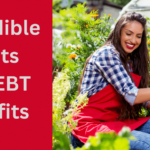The United States government has several assistance programs in each state designed to help those in financial need. If you are working and low-income, you may still be able to get money to help with bills. These federal benefits give free money to support people with food, healthcare, and education basics.
Let’s look at the 12 Government Programs that away free money! Find out how to qualify and what bills you can get help with, and which organizations are near you.
TABLE OF CONTENTS
Do I Qualify for Government Assistance Benefits?
You may be eligible for a government benefit or federal government assistance if your gross family income is at or below the federal poverty level. This is true even if someone in your family is working. You may also qualify if you are,
- You are unemployed,
- Are a single mother
- Are pregnant
- Have a disability
- Are an older person
12 Government Benefit Programs That Give Free Money
Medicaid
Health is one of the priorities when it comes to basic needs. Medicaid, which is funded jointly by the federal and state governments, provides healthcare coverage to eligible Americans. It covers a vast group of people, including children, pregnant women, people with disabilities, and other adults.
In 2020, Medicaid covered 70.6 million people all over the country. Depending on enrollment, Medicaid provides healthcare coverage either free of cost or at a significantly low price. The federal government lays out the rules and provides the bulk of the finances, but it is down to the states to administer it among the eligible beneficiaries.
If you want to enroll in the program, contact your state’s Medicaid agency to go through the process. Here is a link that can assist.
Head Start
This program is geared toward child development and is catered to low-income groups. Children from such families are supported with early learning to make them school-ready. Early learning includes education through games, emotional readiness, basic mathematics and science, and language skills.
The program also takes care of the primary health needs of these children with:
- health screening,
- nutritious meals, and a
- access to healthcare services.
Not only do the children get some benefits, but their parents do, too. The program focuses on parent-child bonding and provides parents with financial, emotional, and societal aid.
It is a free program for children up to age 5. To find out if you are eligible, contact your local Head Start Center. Alternatively, call 1–866–763–6481 Monday through Friday, 8 a.m. to 6 p.m. ET.
Federal Pell Grant Program
Students from low-income families can benefit from the Federal Pell Grant Program, which provides financial aid for post-secondary education. The grant provided by the program is similar to a scholarship in that it does not need to be repaid, unlike a student loan.
The grant amount a student is eligible for is calculated based on:
- the cost of attendance,
- the duration of the college or p
- the postbaccalaureate program, and
- the expected family contribution.
If the student also has a job, their income and assets are considered before finalizing the grant amount.
About 5400 participating institutions in the country offer this grant to eligible students. if you have any questions, here is the phone number you may contact (800) 433-3243 or 800 4FED-AID. You may fill out the free application form using this link to apply for the program.
Women Infants And Children (WIC)
WIC is a government assistance program that caters to the special dietary needs of pregnant and breastfeeding women and children up to age 5. It aims to provide nutritious diets, dietary and health supplements, awareness drives about healthy eating and breastfeeding, and other related services. It also provides qualifying people with access to health services.
The Food and Nutrition Service runs it at national and state levels. To enroll in WIC, you may contact the concerned agency in your state. Here is a list of local agencies where you can sign up.
Child Care Subsidies
Child care is one of the heaviest expenses many families struggle with, especially those with low incomes. To address this, the federal government funds states to run their child care subsidy program, also known as Vouchers and Fee Assistance. The program aims to ease the financial burden on families so that the children can attend school.
Check out the agencies that offer childcare subsidies in your area.
Weatherization Assistance Program (WAP)
The WAP or Weatherization Assistance Program aims to help low-income families lower their energy bills by modifying their homes and making them more energy-efficient. The program is funded by the US Department of Energy and is administered by individual state governments.
State governments collaborate with local communities, non-profit organizations, and county-level government to reach qualifying families. To apply, your total household income must fall below a certain level, which is determined by the number of members in the household. Also, residents above 60, residents with a disability, and families with children are given preference.
Low-Income Heating Energy Assistance (LIHEAP)
LIHEAP is another energy-saving benefits program focusing on heating and cooling energy costs. Other support areas include assistance with bill payments, energy-related repairs, handling energy crises, and weatherization.
To be eligible for this program, you should require help with energy bill payments, and your household income must fall under a specified limit.
You may get more help about applying to the program by contacting your state-level LIHEAP agency, as mentioned in the following link. You may also contact the toll-free number: 1-866-674-6327
Temporary Assistance For Needy Families (TANF)
As the name mentions, this program is meant to help low-income families get back on their feet by providing for them temporarily.
The federal government allows the states to run this program with flexibility. So, how much and what kind of help your family will be eligible for largely depends on where you live.
Most states provide monthly cash to such families, while some state governments might assist with child care or job training.
The families must find a job within a stipulated time before the cash support is withdrawn. Use the following link to learn more about applying for TANF in your state. Find TANF in your state.
Supplemental Nutrition Assistance Program (SNAP)
SNAP is the most extensive food benefits program in the United States, run by the US Department of Agriculture. Through SNAP, eligible low-income families can put food on the table through pre-filled electronic benefits transfer (EBT) cards.
These cards function like debit cards and can be used at designated food stores. The amount a family receives on its SNAP card is decided according to the household size.
Although the program is funded by the federal government, to apply, you must visit one of the agencies in your state. You may go through this link to find the nearest SNAP office.
Child’s Health Insurance Program (CHIP)
CHIP is a separate program designed to help families not qualify for Medicaid. In short, if your family income falls above the threshold mentioned for Medicaid, you can still find out if your children could be covered under CHIP.
There may be a nominal copayment for other services. CHIP coverage varies between states and may also cover pregnant women in some states. However, in general, this program is about providing preventive and emergency care for children.
CHIP Pays for,
- Routine doctor visits
- eye exams,
- medical supplies,
- testing,
- dental visits all free of cost.
To find out whether your children are eligible for CHIP, you may visit the state-run health insurance agencies at the following link. Another way to apply for CHIP is to call 1-800-318-2596. government assistance program. Here is a link to more information
Supplemental Security Income Program (SSI)
SSI is a federal benefit program that helps low-income adults and children with disabilities buy necessities like food, clothes, and shelter. Government funds allocated to this program provide monthly cash payments to eligible individuals.
Another category that may benefit from this program is older adults 65 years and older who fall into the low-income group.
To enroll in this government assistance benefit program, you may visit the following website and file an online disability benefits application. Also, you may call the helpline at 1-800-772-1213. They also have a particular number for those who have hearing disabilities, which is TTY 1-800-325-0778. For more information, visit: https://www.ssa.gov/benefits/ssi/
Subsidized Housing, Vouchers, Public Housing
The government issues housing choice vouchers to families needing low-cost rented homes. Typically, Public Housing Agencies that moderate these vouchers pay the subsidized rent directly to the landlord. The tenant, entitled to the voucher, pays the difference, if any.
Houses allotted under this program vary in categories, from townhouses to apartments and families. Under the government program guidelines, tenants can choose the home they need if the landlord agrees to rent it.
Some families may also be eligible to purchase a house at a subsidized rate. To determine whether you qualify for subsidized housing, click the following link to find your local Public Housing Agency.
You may also call the toll-free number 1-800-955-2232 for further information.











Leave a Reply